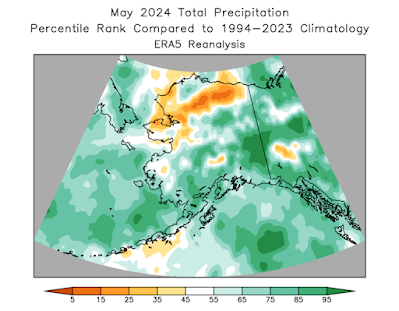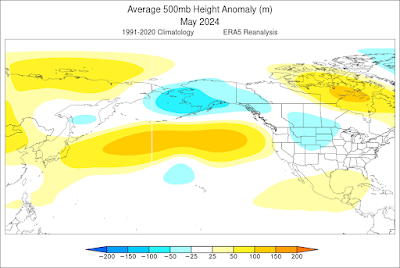The month of May was the coldest since 2013 for Alaska as a whole, according to NOAA/NCEI data, and it was also wetter and cloudier than normal across most of the state - a rather unpleasant end to spring, and problematic for breakup flooding, especially for Kuskokwim River communities. The only somewhat dry region was the Arctic northwest and Brooks Range, according to ERA5 data. Also notable is the fact that it was the first wetter-than-normal month of the year for the southern Panhandle.
The far southwestern mainland and upper Alaska Peninsula saw the most anomalous cold for the month, with the "Bristol Bay" climate division having the coldest May since 2001, and before that 1985. Checking in on a few sites in the region, Iliamna stands out as particularly unusual: the monthly mean temperature of 37.1°F was the coldest since 1971.
The cold and wet pattern was a direct reflection of a cold upper-level trough over southwestern Alaska. The jet stream was well to the south, riding the strong north-south temperature gradient between extreme warmth in the central North Pacific and chilly conditions in the Bering Sea region:
By my calculations, the monthly PDO index of -1.8 was the most negative for May since 1950. The 3-year smoothed PDO index is also the most negative since the early 1950s, illustrating that we're in one of the most entrenched and significant negative PDO regimes in the modern climate history.
As for wind, both northwestern Alaska and the eastern Aleutians were much windier than normal in May, and so was the southern Panhandle, according to ERA5. However, the Arctic coast was relatively calm after a rather windy start to the year.










No comments:
Post a Comment